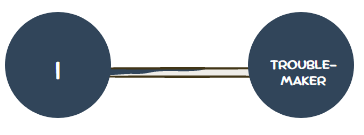LESSON 2.2
Why Tell Stories?
Grades 1-3

We all tell stories all the time. It’s a cool way to share things with others. Even when you chat with your friends about what you did at recess, you’re telling a story.
Have you ever told someone about your day? Or maybe about a funny thing that happened to you? That’s storytelling. Stories can be funny, exciting, or even scary.
Today, we’re going to make a fancy story called a fantasy. The main character, the hero, can be a boy or a girl. Let’s pretend YOU are that hero! In this story, you’ll always be referred to as “I.”
The TWO Parts of a Story:

Every exciting story needs a hero (that’s YOU!) and a troublemaker.
The troublemaker can be anyone or anything too, like a grumpy man, a runaway kite, an alien, or even a storm
For now, let’s make our star a real person, just like you.
Task 2.2.1 – Individual
Draw a barbell on a piece of paper. Use something round, like the lid of a jar, to make each barbell end. Put I on the right circle and troublemaker on the left. What we have is like the ends of a barbell. We can call this the “Barbell of Communication.”
Stories are a fun way to share what’s happening in our lives with others. They can be true, like what you did at school today, or made up, like a wild adventure with aliens and spaceships. Good storytellers know how to effectively communicate in a way that could make us feel happy, excited, or even a little scared.

Task 2.2.2 – Individual
Next, we will put the barbell shape into a box shape. Notice that the top row has the Barbell of Communication plus two more boxes: because and Why. Ignore those for now.
| Barbell of Communication | Because | Why | ||
|---|---|---|---|---|
| Hero | a Troublemaker | |||
The Third Part of a Story
Telling someone what you did at school is ‘sharing information,’ but when you add a problem to solve, that’s what makes it a story.
The middle box of the Communications Barbell should always have had a problem with or had a problem when in it. It will be the “bar” on the “barbell.”
The top row has the Barbell of Communication plus two more boxes: because and Why. Ignore those for now.
| Barbell of Communication | because | Why | ||
|---|---|---|---|---|
| A Hero | had a problem with | a Troublemaker | ||
Now we will label the parts of the barbell:
LH – this is the left-hand of the barbell.
VP – this is the “bar” on the barbell. VP stands for verb phrase.
RH – this is the right-hand of the barbell.
| Barbell of Communication | because | Why | ||
|---|---|---|---|---|
| LH | VP | RH | ||
| Hero | had a problem with | a Troublemaker | ||
Task 2.2.3 – Individual
Draw and fill in the LH – VP – RH of a chart like the one above.
